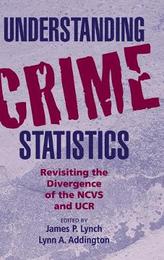
|
Understanding Crime Statistics: Revisiting the Divergence of the NCVS and the UCR
Hardback
Main Details
| Title |
Understanding Crime Statistics: Revisiting the Divergence of the NCVS and the UCR
|
| Authors and Contributors |
Edited by James P. Lynch
|
|
Edited by Lynn A. Addington
|
| Series | Cambridge Studies in Criminology |
|---|
| Physical Properties |
| Format:Hardback | | Pages:356 | | Dimensions(mm): Height 235,Width 158 |
|
| ISBN/Barcode |
9780521862042
|
| Classifications | Dewey:364 |
|---|
| Audience | | Professional & Vocational | |
|---|
| Illustrations |
28 Tables, unspecified
|
|
Publishing Details |
| Publisher |
Cambridge University Press
|
| Imprint |
Cambridge University Press
|
| Publication Date |
4 December 2006 |
| Publication Country |
United Kingdom
|
Description
In Understanding Crime Statistics, Lynch and Addington draw on the work of leading experts on U.S. crime statistics to provide much-needed research on appropriate use of this data. Specifically, the contributors explore the issues surrounding divergence in the Uniform Crime Reports (UCR) and the National Crime Victimization Survey (NCVS), which have been the two major indicators of the level and of the change in level of crime in the United States for the past 30 years. This book examines recent changes in the UCR and the NCVS and assesses the effect these have had on divergence. By focusing on divergence, the authors encourage readers to think about how these data systems filter the reality of crime. Understanding Crime Statistics builds on this discussion of divergence to explain how the two data systems can be used as they were intended - in complementary rather than competitive ways.
Author Biography
James P. Lynch is co-author (with Albert D. Biderman) of Understanding Crime Incidence Statistics: Why the UCR Diverges from the NCS and (with Rita J. Simon) of Immigration the World Over: Statutes, Policies and Practices. He has published in many journals including Criminology, Journal of Quantitative Criminology, and Justice Quarterly. Lynn A. Addington's recent work has appeared in the Journal of Quantitative Criminology and Homicide Studies and has been supported by grants from the American Education Research Association (National Center for Education Statistics - National Science Foundation), the American Statistical Association, the Bureau of Justice Statistics, and the National Institute of Justice.
Reviews'Readers of this volume will understand what survey and police-based data can and cannot tell us about the crime problem and how important it is to thoroughly consider data quality when assessing changes in crime. This book should be required reading for those who analyze crime trends and the factors that might influence changes over time.' Janet Lauritsen, University of Missouri, St Louis 'Lynch and Addington have recruited the field's top scholars on crime statistics to examine the divergence of the National Crime Victimization Survey (NCVS) and Uniform Crime Reports (UCR). The end product of this collection of essays represents the single best summary statement on the topic and should be required reading for all criminologists.' Alex Piquero, University of Florida 'Crime trends are big news - the decline in crime which began in the early 1990s was one of the most significant social facts of the late 20th century. This book explains why and how researchers have worked to address our understanding of crime trends. The book concludes with sensible suggestions for improving the measurement of crime, a necessary step in advancing what we know about why it goes up and down in the first place.' Wesley Skogan, Northwestern University 'The time is ripe to revisit this topic, assess the convergence between the NCVS and UCR in the last 15 years, and apply critical thinking in examining sources of divergence. The individual chapters in this book are useful both as separate statements and as part of the overall discussion about crime statistics and their meaning. These original analyses will contribute to continuing discussions and debates about the validity and reliability of crime statistics.' Christy Visher, The Urban Institute
|